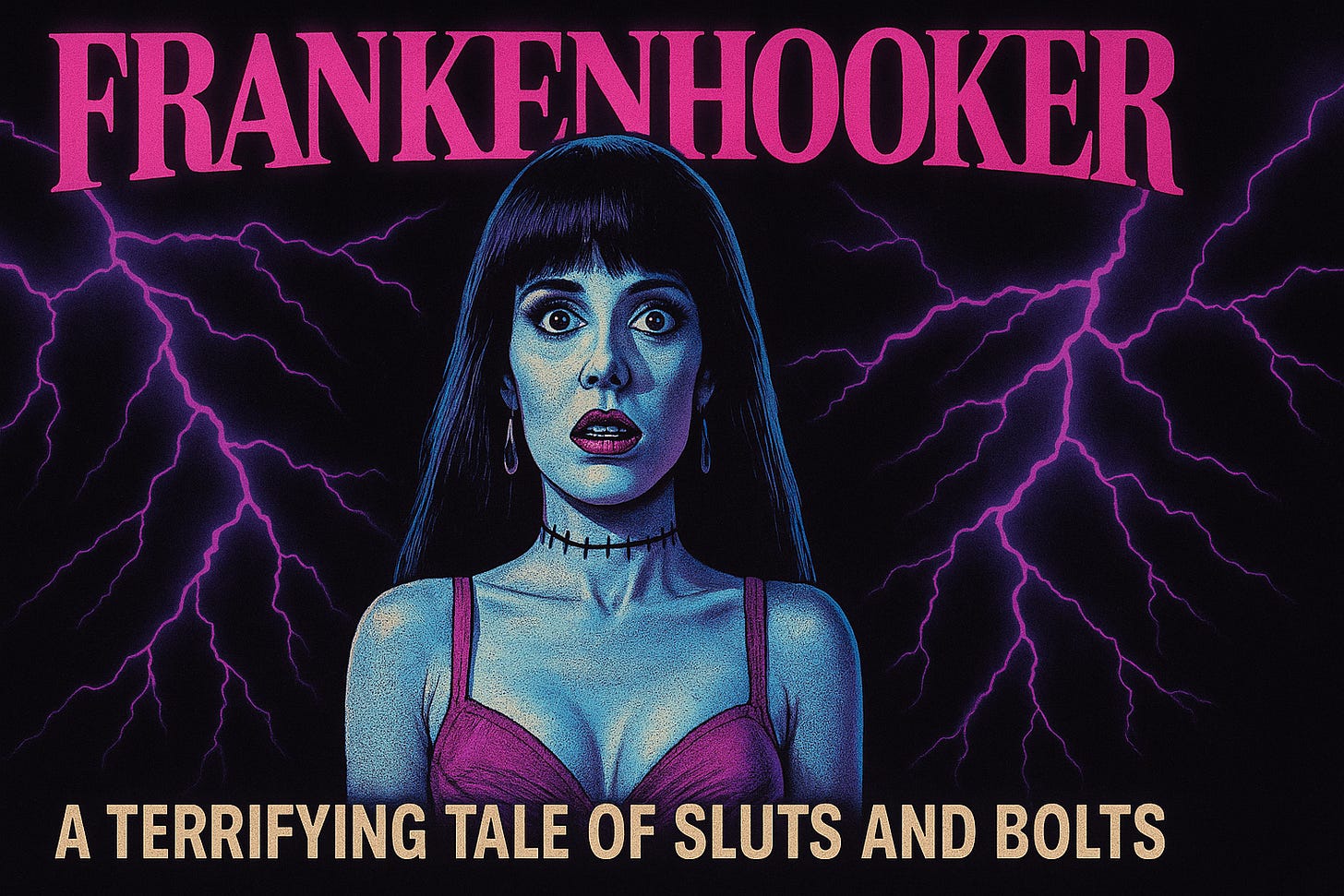Sparks and Flesh: The Divine Trash of Frankenhooker
How a purple-wigged monster, a jar of “super-crack,” and one mad scientist built a cult classic that still shocks, amuses, and strangely endears 35 years later.
In 1990, amid New York’s flickering marquees and the fading pulse of 42nd Street, Frank Henenlotter stitched together a monster. His creation wasn’t made of corpses and lightning—it was born from tabloid culture, trash aesthetics, and the twitching afterglow of the Reagan decade.
He called it Frankenhooker.
The result wasn’t simply another late-night horror flick—it was a delirious comedy about grief, lust, and the electricity of bad ideas. James Lorinz plays Jeffrey Franken, a New Jersey backyard scientist who loses his fiancée to a lawnmower accident and rebuilds her using the body parts of Times Square sex workers and a custom chemical called “super-crack.” It’s pulp, yes—but pulp that somehow bleeds poetry.
The Gospel According to Garbage
Henenlotter once said he didn’t make horror films—he made “exploitation comedies.” Frankenhooker embodies that creed. Every frame hums with sleazy sincerity: garish colors, cartoon explosions, and dialogue that borders on dadaist.
Not everyone was impressed. One review called it “a terrifying tale of sluts and bolts” while another praised it as “genuinely witty” and “weirdly endearing.” The film has since been recognized by The Film Experience for its “gleefully campy” tone and surprising intelligence.
Both sides are right. Frankenhooker is trash—divine, radioactive trash. It’s a fever dream of capitalism and desire, a story of invention gone morally sideways. And it’s hilarious precisely because it never pretends to be respectable.
The Purple-Wigged Resurrection
Patty Mullen plays Elizabeth Shelley (yes, Shelley) with mechanical precision and magnetic charm. Her twitchy, robotic delivery—“Wanna date?”—echoes endlessly, like a haunted ad jingle for human connection.
Her performance has been described by The Film Experience as “riotously funny, knowingly perverted, and ultimately kind of shockingly feminist.” At NJ Horror Con 2019 she and Lorinz still celebrated the movie’s legacy with fans, proving cult fame has a long half-life.
A Psycho Drive-In article went even further, calling her portrayal “the singular most underrated performance in film history.” Like her stitched-together character, Mullen created something wholly new from discarded pieces of cinematic tradition.
Exploding Bodies, Expanding Meanings
At its core, Frankenhooker is about addiction—to drugs, science, love, and control. The “super-crack” sequence, where women literally explode, is absurd and tragic all at once. Hyperreal Film Club interprets it as satire on patriarchal violence and commodification.
Meanwhile, FilmFolly notes the surprising restraint in gore, arguing that Henenlotter aimed for grotesque comedy rather than shock value. Viewers oscillate between revulsion and affection—precisely the point.
A Shared Experiment in Madness
My own encounter with Frankenhooker came through a domestic experiment: my wife went with friends to our local state theater’s midnight showing while I streamed it at home after tucking in the kids.
Halfway through she texted, “You have got to see this.” I replied, “I’m watching it right now.” When the credits rolled, we were both laughing in disbelief—two synchronized viewings, one shared fever dream. The next day’s conversation wasn’t about the effects or the nudity, but about what it all meant.
That, I think, is the power of a movie like this—it drags you into its madness and then makes you talk.
The Cult Afterlife
The film’s initial release was modest: about $205,000 on a $2.5 million budget, but the talking VHS box that chirped “Wanna date?” turned it into video-store legend.
Decades later, Frankenhooker thrives in midnight screenings, Arrow Video restorations, and the nostalgic glow of VHS culture. On Rotten Tomatoes, critics call it “audacious,” “campy,” and “a gem of a comedic performance.” Reddit threads describe it as part of Henenlotter’s “unholy trilogy of tasty trash.” (Reddit)
In the age of streaming, it’s found new life on Amazon Prime Video, where a new generation can experience its mix of sleaze and sincerity.
The Shock of the True
FilmFolly argues that when Jeffrey’s brain is transplanted into a female body at the end, the joke turns philosophical: creation consumes its creator. Hyperreal Film Club reads it as a brutal metaphor for patriarchy devouring itself.
Ridiculous, grotesque, and oddly tender, Frankenhooker remains the rare film that transforms bad taste into cultural revelation. Its laughter hides a scalpel. Its absurdity reveals a truth: America loves to play God, especially when the experiment looks good in neon.
And somewhere, under flickering streetlight and lightning flash, a purple-wigged woman still leans forward and asks,
“Wanna date?”




